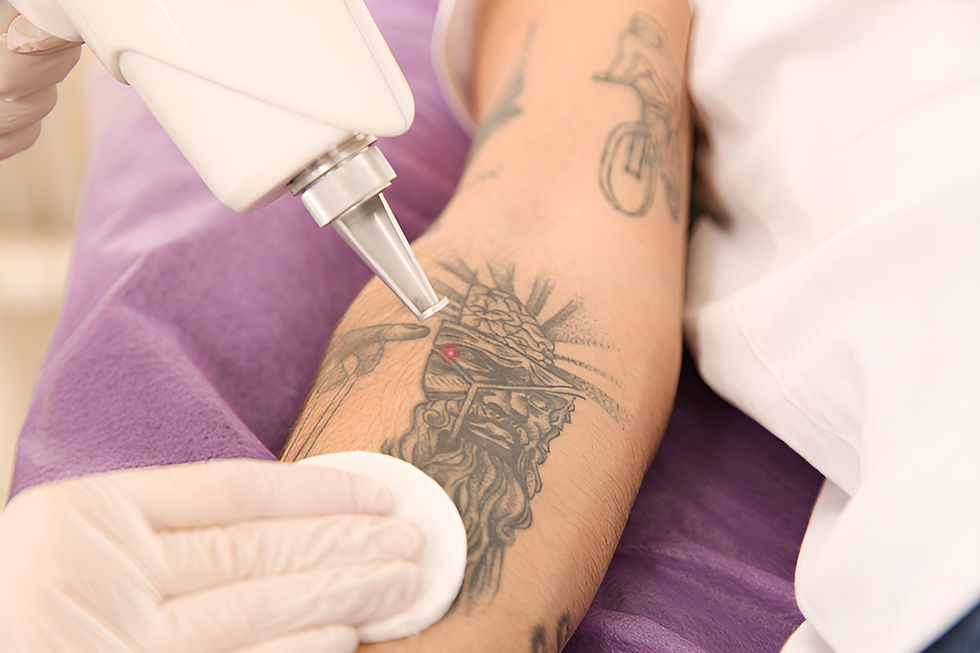Laser Tattoo Removal Effective on All Skin Types?
- danyalmalikdynamic
- Sep 24, 2024
- 4 min read
Tattoo removal has become increasingly popular as people seek to erase past decisions or simply change their body art. One of the most common methods for tattoo removal is laser treatment. While this procedure is widely regarded as effective, many wonder whether it works equally well across all skin types. This article will explore the effectiveness of laser Tattoo Removal in Dubai, examining various skin types and the factors influencing the procedure's success.
Understanding Laser Tattoo Removal
Laser tattoo removal works by targeting the pigment in the tattoo ink. The laser emits high-intensity light beams that break down the ink particles in the skin. Once broken down, the body’s immune system gradually removes these smaller ink particles. The procedure typically requires multiple sessions to achieve optimal results.
The Mechanism of Action
Different types of lasers can be used for tattoo removal, including Q-switched lasers and picosecond lasers. Q-switched lasers deliver short bursts of energy that specifically target the ink without significantly damaging the surrounding skin. Picosecond lasers, on the other hand, use even shorter pulses and can shatter ink particles more efficiently.

Factors Affecting Tattoo Removal
Several factors influence the effectiveness of laser tattoo removal, including:
Ink Color: Different colors absorb laser light differently. Darker inks, such as black and blue, tend to respond better to laser treatments. Lighter colors, such as yellow or green, may require more sessions for complete removal.
Tattoo Age: Older tattoos tend to fade and can be easier to remove. Newer tattoos may still have vibrant colors, making them more resistant to treatment.
Tattoo Location: Tattoos located on areas with better blood circulation, like the arms or legs, may fade more quickly than those in areas with lower circulation.
Skin Type: The effectiveness of laser tattoo removal can vary significantly depending on an individual's skin type.
Skin Types and Laser Tattoo Removal
Understanding the Fitzpatrick scale, which classifies skin types based on their reaction to UV light, can help explain how different skin types respond to laser tattoo removal.
Fitzpatrick Skin Type I
Individuals with skin type I have very fair skin, often with light hair and eyes. They are more susceptible to sunburn and typically do not tan. Laser tattoo removal can be highly effective on this skin type, as the contrast between the ink and the light skin allows the laser to target the tattoo more efficiently. However, there is a higher risk of skin damage or hypopigmentation if not performed carefully.
Fitzpatrick Skin Type II
People with skin type II have fair skin that tans minimally and burns easily. Like skin type I, laser tattoo removal can be effective, but caution must be exercised to avoid adverse effects like blistering or discoloration.
Fitzpatrick Skin Type III
Individuals with skin type III have medium skin that tans gradually and burns moderately. Laser tattoo removal is generally effective on this skin type, but practitioners must adjust the laser settings to minimize risks and ensure optimal results.
Fitzpatrick Skin Type IV
Skin type IV represents olive or light brown skin that tans easily and rarely burns. While laser tattoo removal can be effective, there is an increased risk of hyperpigmentation, especially with aggressive treatments. It is crucial for practitioners to use lasers specifically designed for darker skin tones to achieve successful results.
Fitzpatrick Skin Type V and VI
Individuals with skin types V and VI have darker skin tones, which can pose challenges for laser tattoo removal. The risk of hyperpigmentation increases significantly, and some ink colors may not respond well to treatment. Practitioners may use specialized lasers designed for darker skin to reduce these risks and enhance effectiveness. With careful consideration and expertise, laser tattoo removal can still achieve satisfactory results.
Choosing the Right Practitioner
For effective tattoo removal, it is vital to choose an experienced practitioner, especially when dealing with diverse skin types. A skilled practitioner will consider the patient's skin type, the tattoo's characteristics, and individual health factors to create a tailored treatment plan.
Importance of Consultation
Before undergoing laser tattoo removal, a thorough consultation is essential. During this process, the practitioner will assess the tattoo, discuss the patient's medical history, and evaluate the skin type. This information helps determine the best laser type and settings to use for optimal results.
Aftercare and Recovery
Post-treatment care is crucial for successful tattoo removal. Patients should follow their practitioner’s guidelines, which may include:
Keeping the treated area clean and dry.
Applying prescribed ointments to reduce the risk of infection.
Avoiding sun exposure to minimize the risk of hyperpigmentation.
Expected Results
Results can vary based on several factors, including the individual's skin type and the tattoo's characteristics. While many people can expect significant fading after several sessions, complete removal may take time. Setting realistic expectations during the consultation can help patients feel more satisfied with their results.
Conclusion
Laser tattoo removal in Dubai can be effective for all skin types, but individual responses may vary. Understanding how different skin types interact with laser treatments can guide patients in making informed decisions. By choosing a qualified practitioner and adhering to aftercare recommendations, individuals can enhance their chances of achieving satisfactory results. Whether it’s to remove a regretful tattoo or make way for new art, laser tattoo removal remains a viable option for many seeking a fresh start.
Comments